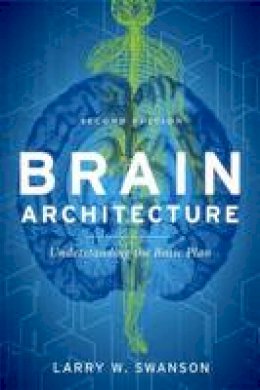
Stock image for illustration purposes only - book cover, edition or condition may vary.
Brain Architecture: Understanding the Basic Plan
Larry W. Swanson
€ 99.66
FREE Delivery in Ireland
Description for Brain Architecture: Understanding the Basic Plan
Paperback. Written in clear and sparkling prose, beautifully illustrated, and thoroughly updated, Brain Architecture, Second Edition is must-read for anyone interested in the science of how the brain works. Num Pages: 352 pages, 93 illus. BIC Classification: PSAN. Category: (G) General (US: Trade). Dimension: 208 x 139 x 20. Weight in Grams: 556.
Now in its second edition, Brain Architecture is the continued exploration of how the brain works. At the very core of our existence, the brain generates our thoughts and feelings, directs our voluntary interactions with the environment, and coordinates all of the vital functions within the body itself. This long-overdue new edition explains this oftentimes daunting intricacy and exquisite detail. The first half of the book discusses the basic parts and how they work, presenting an overview of the nervous system at both the microscopic and macroscopic levels. The approach follows three classic lines of thought that proceed from simple to complex: the history of neuroscience research, the evolution of the nervous system, and the embryological development of the vertebrate central and peripheral nervous systems. The second half of the book outlines the basic wiring diagram of the brain and nervous system-how the parts are interconnected and how they control behavior and the internal state of the body. This is done within the framework of a new four-system network model that greatly simplifies understanding the structure-function organization of the nervous system. Written in clear and sparkling prose, beautifully illustrated, and thoroughly updated, Brain Architecture, Second Edition is must-read for anyone interested in the science of how the brain works.
Product Details
Publisher
Oxford University Press Inc United States
Number of pages
344
Format
Paperback
Publication date
2011
Condition
New
Weight
555 g
Number of Pages
352
Place of Publication
New York, United States
ISBN
9780195378580
SKU
V9780195378580
Shipping Time
Usually ships in 15 to 20 working days
Ref
99-14
About Larry W. Swanson
Larry W. Swanson, PhD, is Milo Don and Lucille Appleman Professor of Biological Sciences at the University of Southern California in Los Angeles, CA. Dr. Swanson has published over 250 research articles and numerous books on brain organization, and is a member of National Academy of Sciences, American Academy of Arts and Sciences, and the Grolier Club.
Reviews for Brain Architecture: Understanding the Basic Plan
Neuroanatomy is usually associated with boring memorization and dense terminology. But Swanson has brought the subject to life by focusing on the principles that underlie brain structure and function. These principles, illuminated by an historical perspective and placed in an evolutionary context, actually constitute a theory of brain. This book's logical organization, intellectual sweep, and clear writing made it a joy for me to read.
Charles F. Stevens, MD, PhD, Howard Hughes Medical Institute, The Salk Institute for Biological Sciences
Larry Swanson, one of the great contemporary students of brain anatomy, has given us a broad overview of the structure and function of the brain using insights from embryology and from evolutionary comparison to highlight the principles that govern the anatomical substrates of behavior. This book will be read avidly by both students and practicing scientists.
Eric R. Kandel, MD, Howard Hughes Medical Institute, Columbia University, Nobel Laureate in Physiology or Medicine
I was pleasantly surprised by the comparative and evolutionary approach used to introduce the major concepts, and I was drawn in by the historical context in which the story is told...a clearly written and logically organized overview of the major functional subdivisions of the vertebrate nervous system...Swanson's writing style and his ability to present complicated systems and relationships will make this book particularly accessible to students, and generally useful to anyone interested in the neurosciences...commendable job distilling the essential principles from an exceptionally complex subject, making the brevity of this book one of its greatest strengths.
Kenneth C. Catania in Nature Neuroscience
This short book deserves wide readership. It could serve both as a general introduction for the undergraduate and as a means to wide one's horizon for the experienced researcher.
Jan Voogd, Science
Charles F. Stevens, MD, PhD, Howard Hughes Medical Institute, The Salk Institute for Biological Sciences
Larry Swanson, one of the great contemporary students of brain anatomy, has given us a broad overview of the structure and function of the brain using insights from embryology and from evolutionary comparison to highlight the principles that govern the anatomical substrates of behavior. This book will be read avidly by both students and practicing scientists.
Eric R. Kandel, MD, Howard Hughes Medical Institute, Columbia University, Nobel Laureate in Physiology or Medicine
I was pleasantly surprised by the comparative and evolutionary approach used to introduce the major concepts, and I was drawn in by the historical context in which the story is told...a clearly written and logically organized overview of the major functional subdivisions of the vertebrate nervous system...Swanson's writing style and his ability to present complicated systems and relationships will make this book particularly accessible to students, and generally useful to anyone interested in the neurosciences...commendable job distilling the essential principles from an exceptionally complex subject, making the brevity of this book one of its greatest strengths.
Kenneth C. Catania in Nature Neuroscience
This short book deserves wide readership. It could serve both as a general introduction for the undergraduate and as a means to wide one's horizon for the experienced researcher.
Jan Voogd, Science
